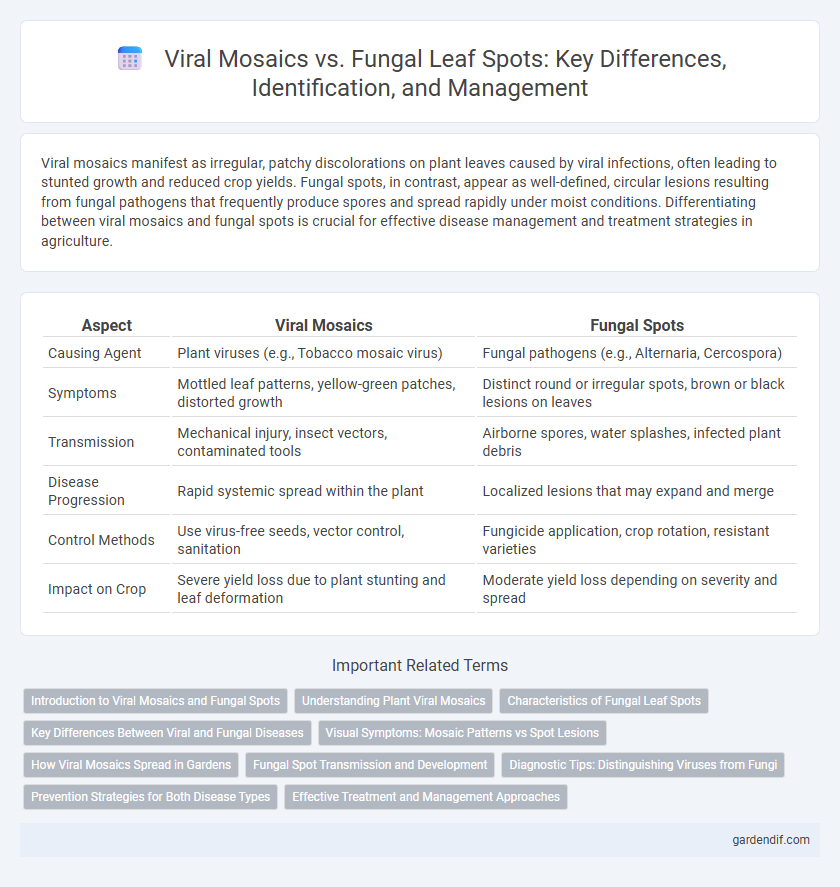
Viral Mosaics vs Fungal Spots Illustration
Viral mosaics manifest as irregular, patchy discolorations on plant leaves caused by viral infections, often leading to stunted growth and reduced crop yields. Fungal spots, in contrast, appear as well-defined, circular lesions resulting from fungal pathogens that frequently produce spores and spread rapidly under moist conditions. Differentiating between viral mosaics and fungal spots is crucial for effective disease management and treatment strategies in agriculture.
Table of Comparison
| Aspect | Viral Mosaics | Fungal Spots |
|---|---|---|
| Causing Agent | Plant viruses (e.g., Tobacco mosaic virus) | Fungal pathogens (e.g., Alternaria, Cercospora) |
| Symptoms | Mottled leaf patterns, yellow-green patches, distorted growth | Distinct round or irregular spots, brown or black lesions on leaves |
| Transmission | Mechanical injury, insect vectors, contaminated tools | Airborne spores, water splashes, infected plant debris |
| Disease Progression | Rapid systemic spread within the plant | Localized lesions that may expand and merge |
| Control Methods | Use virus-free seeds, vector control, sanitation | Fungicide application, crop rotation, resistant varieties |
| Impact on Crop | Severe yield loss due to plant stunting and leaf deformation | Moderate yield loss depending on severity and spread |
Introduction to Viral Mosaics and Fungal Spots
Viral mosaics manifest as irregular, mottled patterns on leaves, often yellow or light green, caused by plant viruses disrupting chlorophyll production. Fungal spots appear as distinct, circular lesions with defined borders and varying colors, resulting from fungal pathogen infection. Both conditions impair photosynthesis and plant health but differ in pathogen type, symptom presentation, and management strategies.
Understanding Plant Viral Mosaics
Plant viral mosaics manifest as irregular, patchy discolorations on leaves, often characterized by light and dark green patterns disrupting normal chlorophyll distribution. These symptoms result from viral infections that interfere with cellular processes, leading to chloroplast damage and impaired photosynthesis, unlike fungal spots which typically produce localized necrotic lesions with fungal growth structures. Accurate diagnosis through symptom analysis and molecular testing is critical for managing viral mosaics, as they do not respond to fungicides and require specific virus-resistant cultivars or vector control strategies.
Characteristics of Fungal Leaf Spots
Fungal leaf spots are characterized by distinct, often circular lesions with well-defined edges that can vary in color from brown and black to yellow or tan. These spots frequently exhibit concentric rings or a target-like pattern, and their presence can cause premature leaf drop and reduced photosynthetic activity. Unlike viral mosaics, fungal spots are usually raised or sunken and may be accompanied by fungal structures such as spores or fruiting bodies visible under magnification.
Key Differences Between Viral and Fungal Diseases
Viral mosaics typically cause irregular, mottled patterns of discoloration on plant leaves due to the infection of plant cells by viruses, often leading to stunted growth and distorted leaves. Fungal spots are characterized by distinct, localized lesions or spots caused by fungal pathogens that penetrate the plant tissue, frequently resulting in leaf necrosis and the presence of spores. Unlike fungal diseases, viral infections do not produce spores and are transmitted mainly through vectors such as insects, making their management and control markedly different.
Visual Symptoms: Mosaic Patterns vs Spot Lesions
Viral mosaics manifest as irregular, patchy patterns of light and dark green on leaves, creating a distinctive mottled appearance often resembling a mosaic tile design. Fungal spots typically appear as well-defined, circular lesions that may be brown, black, or yellow, often surrounded by a halo or border indicating infection progression. Differentiating between mosaic patterns and spot lesions is crucial for accurate diagnosis and targeted disease management in crops.
How Viral Mosaics Spread in Gardens
Viral mosaics spread in gardens primarily through vectors such as aphids, whiteflies, and thrips that feed on infected plants and transmit the virus to healthy ones. Mechanical transmission also occurs via contaminated tools, hands, or plant debris, facilitating rapid infection within garden beds. Unlike fungal spots, which often arise from spores landing on leaf surfaces, viral mosaics rely heavily on insect vectors for widespread dissemination.
Fungal Spot Transmission and Development
Fungal spot transmission primarily occurs through airborne spores that settle on plant surfaces, initiating infection under warm, moist conditions favorable for fungal growth. Once the spores germinate, the fungus penetrates the leaf tissue, leading to necrotic lesions characterized by distinct, circular spots with defined edges. Environmental factors such as high humidity and poor air circulation accelerate fungal development, causing rapid disease progression and significant crop yield losses.
Diagnostic Tips: Distinguishing Viruses from Fungi
Identification of viral mosaics relies on observing irregular, often mosaic-like discolorations on leaves, with symptoms spreading rapidly and showing no fungal fruiting bodies. Fungal spots typically present as well-defined, circular lesions with visible spore-producing structures and often include signs like mycelial growth or powdery coatings. Diagnostic confirmation involves microscopic examination and molecular tests such as PCR to detect viral RNA or fungal DNA sequences.
Prevention Strategies for Both Disease Types
Effective prevention strategies for viral mosaics include using virus-free seeds, implementing crop rotation, and controlling insect vectors such as aphids to reduce virus transmission. For fungal spots, prevention focuses on practicing proper field sanitation, applying fungicides at early infection stages, and improving air circulation through adequate plant spacing. Integrating resistant crop varieties and timely monitoring significantly enhances overall disease management for both viral mosaics and fungal spots.
Effective Treatment and Management Approaches
Viral mosaics, caused by plant viruses like Tobacco Mosaic Virus (TMV), require management through resistant crop varieties and strict sanitation to prevent spread since chemical treatments are ineffective. Fungal spots, often triggered by pathogens such as Alternaria and Cercospora species, respond well to fungicides and cultural practices like crop rotation and proper irrigation. Integrated pest management combining resistant varieties, chemical control, and environmental adjustments offers the most effective approach for managing both viral mosaics and fungal spots.
Viral Mosaics vs Fungal Spots Infographic

 gardendif.com
gardendif.com